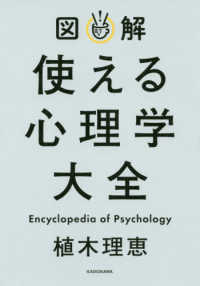Full Description
This guide gives students a solid grounding in the basic methodology of how to analyse corpus data to study new words entering the language or language change. It uses a number of case studies to provide insights into collocations, phraseology, metaphor and metonymy, syntactic structures, male and female language, and language change. Students will become proficient in the key concepts in semantic change by applying ideas from theoretical semantics to historical data. They will also cover recent work at the intersections between historical semantics and other disciplines.
Contents
Chapter 1: Introduction; Chapter 2: A brief history of the English lexicon; 2.1 Introduction; 2.2 Old English (OE: 700-1150); 2.3 Middle English (ME: 1150-1500); 2.4 Early Modern English (EModE: 1500-1750); 2.5 Late Modern English (LModE: 1750 to present day); 2.6 Conclusion: The Present Day; Chapter 3: Categories of meaning; 3.1. Introduction; 3.2 Traditional approaches to Semantics; 3.2.1 Reference; 3.2.2 Sense; 3.2.2.1 Sense relationships; 3.2.3 Components, sets and fields; 3.2.4 A note on homonymy; 3.2.5 A memory aid; 3.3 Categories and prototypes; 3.3.1 Prototypes in action; 3.3.2 Lexical prototypes; 3.3.3 Homonymy revisited; 3.4 Domains and frames; 3.5. Conclusion; Chapter 4: Tracing the development of individual words; 4.1 Introduction; 4.2 Introducing the OED; 4.2.1 OED1; 4.2.2 OED2; 4.2.3 OED3; 4.3 What the OED tells us; 4.3.1 manga2; 4.3.2 monster; 4.3.2.1 Formal history and etymology of monster; 4.3.2.2 Semantic history; 4.3.3 Overview; 4.4 Some other historical dictionaries; 4.4.1 Middle English Dictionary (MED); 4.4.2 Anglo-Norman Dictionary (AND); 4.4.3 Dictionary of the Scots Language (DSL); 4.4.4 Dictionary of Old English (DOE); 4.4.5 Other dictionaries; 4.5 Historical corpora; Chapter 5: How and why words change meaning; 5.1 Introduction; 5.2 The significance of meaning change; 5.3 Studying semantic change; 5.4 The process of semantic change; 5.5 Categories of meaning change; 5.5.1 Widening (or broadening or generalisation) and narrowing (or specialisation); 5.5.2 Amelioration (or elevation) and pejoration (or deterioration or degeneration); 5.5.3 Metaphor and metonymy; 5.6 Grammaticalisation; 5.7 Why do words change meaning?; 5.7.1 External factors; 5.7.2 Internal factors: polysemy, homonymy, synonymy; 5.7.3 Stylistic factors; 5.8 Conclusion; Chapter 6: Larger categories; 6.1 Introduction; 6.2 A brief history of thesauruses; 6.3 The structure of thesauruses; 6.3.1 Basic level and other categories; 6.3.2 Folk and expert categories; 6.4 Using HTOED; 6.4.1 The structure of HTOED; 6.4.2 Inside HTOED categories; 6.5 Conclusion; Chapter 7: English Colour Terms: A case study, C. P. Biggam; 7.1 Introduction; 7.2 How to describe colour; 7.3 What are Basic Colour Terms?; 7.4 The evolution of basic colour categories; 7.5 The development of colour terms in English; 7.5.1 Old English (OE: 700-1150); 7.5.2 Middle English (ME: 1150-1500); 7.5.3 Modern English (ModE 1500-); 7.6 The changing nature of a basic category: BLUE; 7.7 Summary; 7.8 Conclusion; Chapter 8: Language and culture; 8.1 Introduction; 8.2 Linguistics and anthropology; 8.3 Pronouns of address; 8.4 Kinship; 8.4.1 Recent changes; 8.5 Time; 8.6 Conclusion; Chapter 9: Metaphor and metonymy; 9.1 Introduction; 9.2 Metaphor in language and thought; 9.3 Another kind of mapping: metonymy; 9.4 Metaphor and motivation; 9.5 Metonymy and motivation; 9.6 Conclusion; Chapter 10: The big picture and a look ahead; 10.1 Introduction; 10.2 The big picture; 10.3 Green as an example; 10. 4 Looking ahead; References; Glossary of key terms; Index
-

- 電子書籍
- 【無料小冊子】ナツイチGuide202…
-

- 電子書籍
- 長門有希ちゃんの消失【分冊版】 38 …
-

- 和書
- 図解使える心理学大全
-

- 電子書籍
- 佐伯さんと、ひとつ屋根の下 I'll …
-

- 電子書籍
- ダンドリくん(1) 世の中データとダン…



